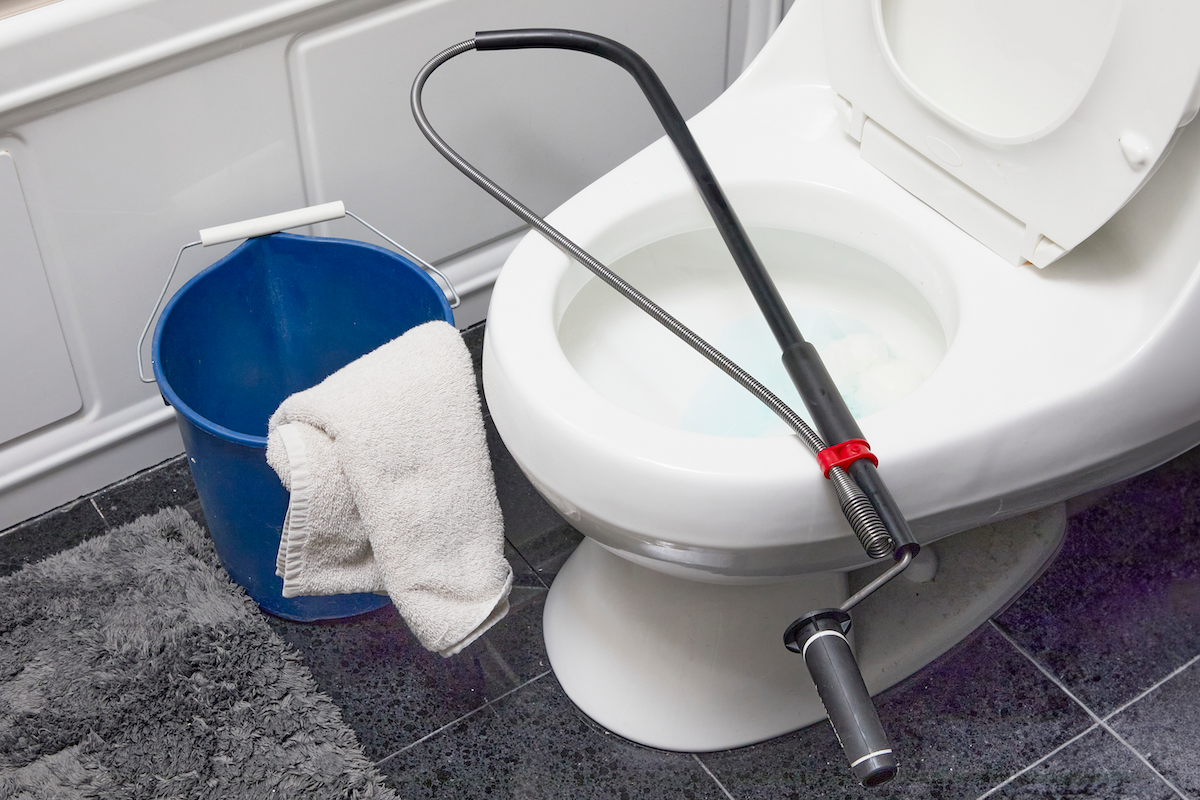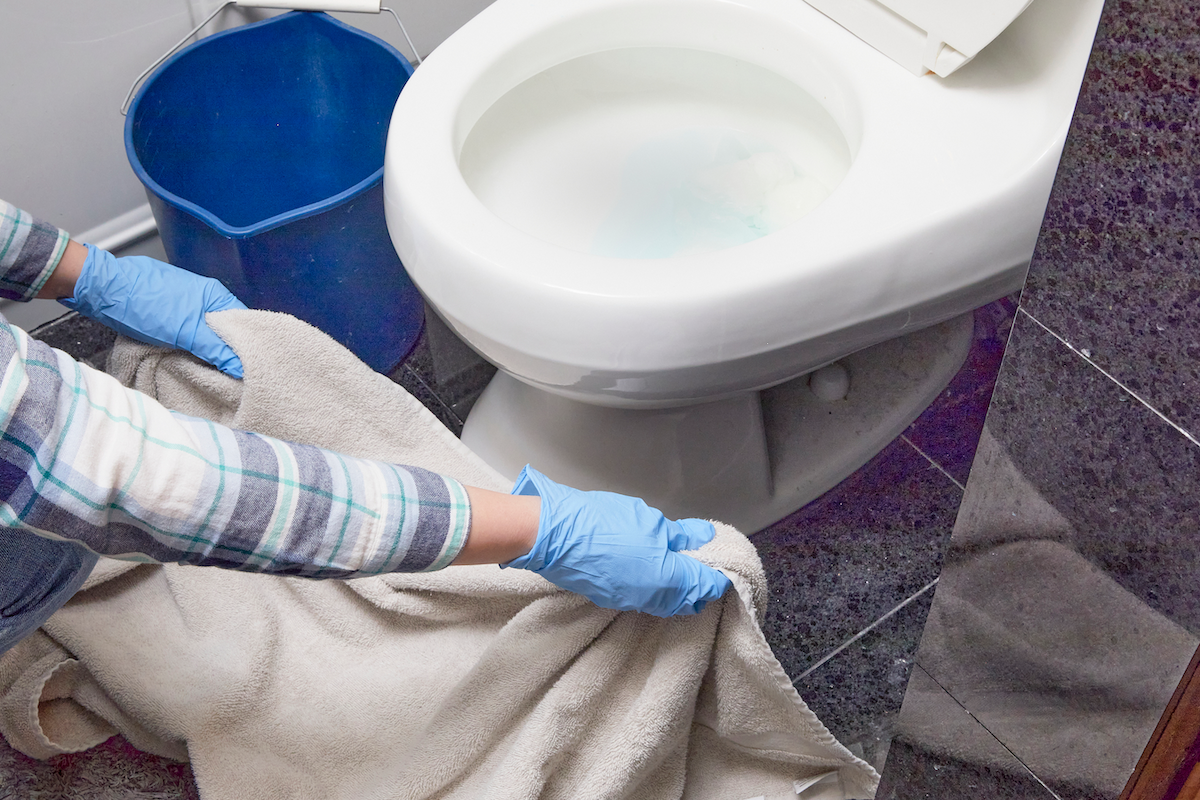

We may earn revenue from the products available on this page and participate in affiliate programs. Learn More ›
Let’s face it: Dealing with a clogged toilet is about as much fun—but, unfortunately, just as necessary—as a root canal. When you’re stuck with a clogged or slow-draining toilet, the plunger should always be your first plan of attack. Plungers are quick, easy to use, and great for minor clogs, but be aware that they may just simply push the clog a little farther down the pipe.
If the plunger doesn’t do the job, don’t rush off and call the plumber quite yet. Instead, summon the toilet snake, also known as a closet snake, closet auger, or toilet auger. With this specialized plumbing tool and a little persistence, a typical DIYer should be able to learn how to use a toilet snake to tackle a straightforward clog and flush the problem away.
Tools & Materials
Bobvila.com may earn a commission from purchases made through these links.
Step 1: Rent or buy a toilet snake.

If you don’t own a drain snake, you can either purchase one or you can rent one from a home center for about $15 a day. Prices range from $15 to $70 or even more, depending on the length of the cable, the sturdiness of the tool, and any extra features. Either option is less expensive than the average cost of bringing in a plumber, which can run upward of $100 per hour.
Before you get to work, familiarize yourself with the mechanics of the toilet snake. It’s essentially a long metal cable that sits in a hollow tube with a curved fitting at the base. This curve angles into the toilet drain, making it easier to feed the cable through to unclog the drain. A rubber sleeve at this end protects the toilet from scratches from the metal cable, and a crank at the other end helps work the cable down into the pipe. There are also powered augers that attach to a drill or driver, but manual augers are usually up to the task, and they’re also cheaper, easier to use, and less likely to cause damage. Kodi Wilson, campus director of National Technical Institute’s Las Vegas campus, cautions, “I would never recommend a homeowner to work with a powered snake on their own. This would risk injury and property damage. A hand-driven auger, on the other hand, is a great backup to a plunger.”
Step 2: Prep the bathroom.

Put on your rubber gloves and place a large, empty bucket next to the toilet. Have some towels ready in case you make a mess.
Step 3: Place the snake in the toilet bowl.
Holding onto the tube with one hand, use the other to pull back the handle of the snake so the end of the cable is near the end of the tube; the curved “boot” should protect the bottom of the toilet from scratches. Position the end of the snake in the toilet drain, aiming the cable toward the back of the drain.
Step 4: Feed the snake into the drain.

Holding the tube of the snake firmly in place with one hand, use the other to push down on the handle while turning it clockwise to extend the cable down into the drain. You may feel a little resistance as you feed the snake around curves. (Snaking a toilet drain can require patience, and you may need to work the cable forward and back a bit to move it farther down the drain.) Keep going until the snake hits something and won’t go any farther—you’ve reached the clog.
Pull back slightly on the snake. If you feel resistance, you may have hooked the source. If so, pull back on the cable to bring the clog to the surface. Remove it from the bowl and dispose of it in the bucket.
But you don’t have to actually pull out the clog. You can instead break it up into smaller pieces that can travel down the drain. “Pushing or pulling the clog doesn’t really matter. The goal is to get your drain flowing again,” Wilson says. There are, however, exceptions. “Septic systems can be more sensitive to what can go down the drain. If you know the clog is a toy or a diaper or something else that should not be in the drain, it is best to try and remove it. You often don’t have a choice, though; it’s more of a hope that your auger catches rather than pushes it through,” he adds.
To break up a clog, crank the cable as far as it will go, and then work it forward and backward, turning alternately clockwise and counterclockwise. Once you’re able to move the snake farther and more freely, you’ve breached the clog. Remove the auger and stick the business end in the bucket.
Step 5: Flush the clog.
You may want access to the flush valve if the toilet starts to overflow when you flush, so before doing a test flush, remove the tank lid and set it aside carefully. Then flush the toilet and confirm that the water rushes down the bowl.
If the toilet flushes successfully, you’re done. But if the water continues to rise, quickly turn the water shutoff behind the toilet clockwise until the water stops. If you can’t get to it fast enough, lift the float arm (the horizontal arm at the top right of the fill valve that attaches to the float) to cut off the flow of water, and hold it up (or find something to wedge it in place) while you access the shutoff. Alternatively, simply disconnect the refill tube (the small tube that carries water from the fill valve to the overflow tube) and let the water run into the tank until the water level triggers the valve to shut.
For a toilet that flushes but drains slowly, try plunging first—you may not need to snake the toilet drain again. But if it’s completely clogged, you’ll need another go with the snake.
Step 6: Clean the area.

To clean up, throw out any large clumps and then flush the rest back into the toilet in small amounts, making sure it all goes down without causing a new clog. Then thoroughly clean the bucket and the auger with hot water and bleach or vinegar before putting it away or returning it to the store. Finally, keep an eye on the toilet over the next few days to make sure everything’s still running smoothly.
How to Avoid Future Toilet Clogs
Now that you know how to use a snake to unclog a toilet, save yourself from a repeat performance by being careful with what you and your family put in the commode. The safest approach is to flush toilet paper only. Never flush sanitary products, paper towels, tissue paper, cotton balls, cotton swabs, dental floss, or hair. If you have particularly old or sensitive pipes, consider switching to a lower-ply brand of toilet paper to help keep things moving along.
Other Ways to Unclog a Toilet

First of all, avoid using caustic drain cleaners to unclog your toilet bowl. Some of these products can be bad for the environment and may damage toilets and plumbing pipes. (If you do end up calling in the pros after using a heavy-duty drain cleaner, be sure to let the plumbers know so they can take precautions to do the work safely.) There are, however, some DIY ways to unclog a toilet if you have neither a plunger nor a snake handy.
- Baking soda and vinegar: Add or remove water from the bowl so it’s filled halfway with water. Pour in about 1 cup of baking soda and follow up with at least 1 cup of distilled white vinegar. Wait about 30 minutes and then pour hot (not boiling) water down the drain. If the water level drops or you see bubbles rising up through the water, try flushing the toilet. (Be ready to shut off the water and grab some towels if the bowl starts overflowing.) If you have a plunger, try plunging. Repeat the process if necessary.
- Dish soap: Pour about 1 cup of dish soap—choose a dense, grease-cutting variety—steadily into the bowl so it drops to the bottom. After an hour, slowly pour some hot, not boiling, water into the bowl and wait about 30 minutes. (We find that pouring water from a standing height, rather than just above the toilet, gets better results.) Try flushing the toilet, but again, be ready to shut off the water and lay down some towels if the bowl starts to overflow.
When to Call a Plumber
Don’t give up too quickly when you’re snaking the toilet. It may take several tries to manipulate the cable into position and break up or remove the clog. But if you’ve been persistent and the toilet is still clogged, call in a trusted plumber. Wilson advises consulting a pro “if you need to remove the toilet, if the clog is beyond 6 feet, or if this is a recurring issue. Plumbers can use their expertise to evaluate the problem and approach it with the best long-term solution while providing the homeowner with information about the cause.”
